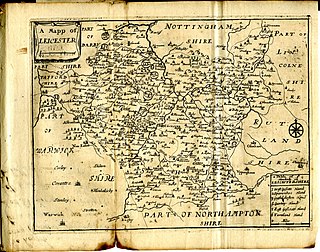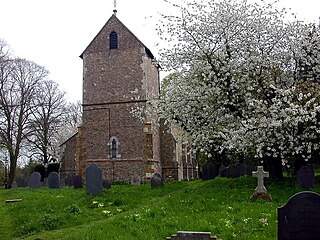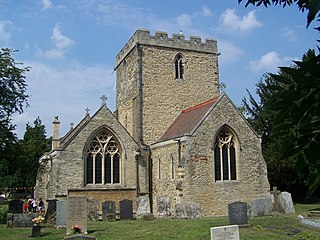
Donisthorpe is a village in the North West Leicestershire district of Leicestershire, England, historically an exclave of Derbyshire.

Shepshed is a market town and civil parish in the Charnwood Borough of Leicestershire, England with a population of 14,875 at the 2021 census. It is the second biggest settlement in the borough, after the town of Loughborough.

Wycomb is a small hamlet in the district of Melton, which is approximately 4 miles (6.4 km) northeast of Melton Mowbray in Leicestershire, and is part of the civil parish of Scalford, which also includes the neighbouring village of Chadwell. Until 1 April 1936 it was in the parish of Wycomb and Chadwell.
Framland was a hundred in north-east Leicestershire, England, roughly corresponding to today's borough of Melton. It was recorded in the Domesday Book as one of Leicestershire's four wapentakes.
Sparkenhoe was a hundred of Leicestershire, England in the south-west of the county, covering Market Bosworth and Hinckley, broadly corresponding to the modern districts of Blaby and Hinckley and Bosworth. The meeting place of the Sparkenhoe Hundred was probably at Shericles Farm near Desford (SK467026), which derives from scirac meaning "the hundred oak". Sparkenhoe hundred was not recorded in the Domesday Book as a wapentake, being formed in 1346 from part of Guthlaxton and Goscote.
Goscote was a wapentake in the county of Leicestershire, England; consisting of the north and north-west of the county. It was recorded in the Domesday Book, but as the wapentakes evolved to form hundreds, was split into East Goscote Hundred and West Goscote Hundred in 1346.

Groby is a village in the Hinckley and Bosworth borough Leicestershire, England. It is to the north west of Leicester. The population at the time of the 2011 census was 6,796.

This article is intended to give an overview of the history of Leicestershire.

Scraptoft is a village in Leicestershire, England. It has a population of about 1,500, measured at the 2011 census as 1,804. It lies north of the A47 road east of Leicester, and runs directly into the built up area of Thurnby and Bushby to the south. For local government the village forms part of the district of Harborough, and constitutes a civil parish.

Barrow upon Soar is a large village in northern Leicestershire, in the Soar Valley between Leicester and Loughborough, with a population at the 2011 census of 5,856.

Newbold Verdon is a village and civil parish in the county of Leicestershire, England. The parish includes Newbold Heath to the north and Brascote to the south. Originally an agricultural centre Newbold Verdon grew in size during the 1850s with the expansion of coal mining in the area. That industry has now ceased leaving Newbold Verdon as a commuter village primarily serving Leicester and Hinckley. The 2001 census recorded a population of 3,193, which had reduced to 3,012 at the 2011 census. In 2000 the village was bestowed the title Newbold Verdon 2000, after local resident Robbie Williams gained a hit number one with his song Millennium.

East Goscote is a modern village and civil parish in the Borough of Charnwood district of Leicestershire, England, just north of the market town of Syston. It is a medium-sized village, with a population measured at 2,866 in the 2011 census. The village is twinned with Fleury-sur-Andelle, France.
East Goscote Hundred was a hundred of Leicestershire, that arose from the division of the ancient Goscote hundred into two. It covered the eastern part of today's Charnwood district, along with the northern part of Harborough District, and extended south-east to meet Rutland.

Bruntingthorpe is a village and civil parish in the Harborough district of Leicestershire, England. According to the census in 2001 the parish had a population of 398. The parish also includes the hamlet of Upper Bruntingthorpe. The population at the 2011 census had increased to 425. the village contains a pub called the plough, a restaurant called the joiners and a garage called bruntingthorpe motor engineers.

Barton Seagrave is a large village and civil parish in the North Northamptonshire, England. The village is about 1.5 miles (2.4 km) south-east of Kettering, town centre. The older part of the village is known for its Norman Church and attractive buildings.

Gaddesby is a village and civil parish in the Melton borough of Leicestershire, England. The population of the civil parish at the 2011 census was 762. It is located around 5.5 miles (8.9 km) southwest of Melton Mowbray and 8 miles (13 km) northeast of Leicester.

Stephen de Segrave was a medieval Chief Justiciar of England.

Little Stretton is a small village and civil parish in the Harborough district of Leicestershire that lies approximately 5.53 miles (8.90 km) southeast of the city of Leicester. The parish includes the deserted medieval village of Great Stretton, a Scheduled Ancient Monument that is located 0.7 miles (1.1 km) to the west of the village. The Gartree Road, a Roman Road, runs through the parish, adjacent to both Little and Great Stretton, and is the reason for those settlements' names. According to the University of Nottingham English Place-names project, the settlement name Stretton means "strēt" (Anglian) for a Roman road; and "tūn" for a settlement or an estate. The population of the civil parish at the 2011 census was 92, with approximately 36 households.
The identification of Deserted Villages and Lost Places in Leicestershire owes much to the pioneering work of William George Hoskins during his time at the University of Leicester.






















